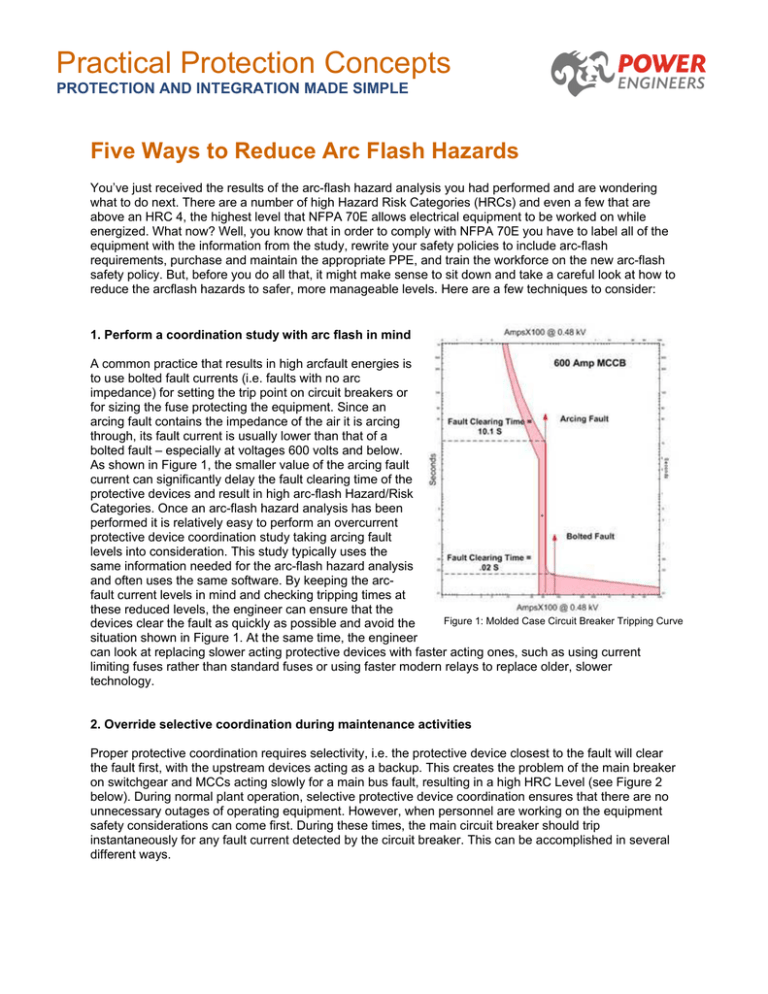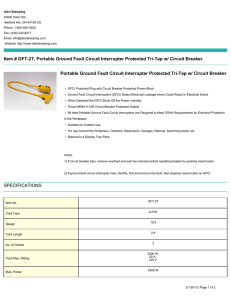Practical Protection Concepts
advertisement

Practical Protection Concepts PROTECTION AND INTEGRATION MADE SIMPLE Five Ways to Reduce Arc Flash Hazards You’ve just received the results of the arc-flash hazard analysis you had performed and are wondering what to do next. There are a number of high Hazard Risk Categories (HRCs) and even a few that are above an HRC 4, the highest level that NFPA 70E allows electrical equipment to be worked on while energized. What now? Well, you know that in order to comply with NFPA 70E you have to label all of the equipment with the information from the study, rewrite your safety policies to include arc-flash requirements, purchase and maintain the appropriate PPE, and train the workforce on the new arc-flash safety policy. But, before you do all that, it might make sense to sit down and take a careful look at how to reduce the arcflash hazards to safer, more manageable levels. Here are a few techniques to consider: 1. Perform a coordination study with arc flash in mind A common practice that results in high arcfault energies is to use bolted fault currents (i.e. faults with no arc impedance) for setting the trip point on circuit breakers or for sizing the fuse protecting the equipment. Since an arcing fault contains the impedance of the air it is arcing through, its fault current is usually lower than that of a bolted fault – especially at voltages 600 volts and below. As shown in Figure 1, the smaller value of the arcing fault current can significantly delay the fault clearing time of the protective devices and result in high arc-flash Hazard/Risk Categories. Once an arc-flash hazard analysis has been performed it is relatively easy to perform an overcurrent protective device coordination study taking arcing fault levels into consideration. This study typically uses the same information needed for the arc-flash hazard analysis and often uses the same software. By keeping the arcfault current levels in mind and checking tripping times at these reduced levels, the engineer can ensure that the Figure 1: Molded Case Circuit Breaker Tripping Curve devices clear the fault as quickly as possible and avoid the situation shown in Figure 1. At the same time, the engineer can look at replacing slower acting protective devices with faster acting ones, such as using current limiting fuses rather than standard fuses or using faster modern relays to replace older, slower technology. 2. Override selective coordination during maintenance activities Proper protective coordination requires selectivity, i.e. the protective device closest to the fault will clear the fault first, with the upstream devices acting as a backup. This creates the problem of the main breaker on switchgear and MCCs acting slowly for a main bus fault, resulting in a high HRC Level (see Figure 2 below). During normal plant operation, selective protective device coordination ensures that there are no unnecessary outages of operating equipment. However, when personnel are working on the equipment safety considerations can come first. During these times, the main circuit breaker should trip instantaneously for any fault current detected by the circuit breaker. This can be accomplished in several different ways. Perhaps the easiest way is for maintenance personnel to manually change the circuit breaker trip settings to instantaneous whenever work is to be performed on the equipment. After the work is completed the worker would then change the settings back to the normal operating settings. Although this method is effective it has several disadvantages. First, the circuit breaker will effectively be out of service during the time the settings are changed. Second, this method requires the operating personnel to remember to reset the breaker to the normal operating configuration when the work is complete. And, finally, errors can be made when setting and resetting the circuit breaker, compromising the protection it offers. A more effective way to accomplish Figure 2: 480 Volt Switchgear Faults. For a fault at F1 the fault is cleared by the Feeder Circuit Breaker with the delayed Main Circuit Breaker acting as a back-up. the circuit breaker setting change is to For a fault at F2 the fault is cleared by the delayed Main Circuit Breaker. install a maintenance switch on the circuit breaker that workers use to enable the circuit breaker instantaneous setting while personnel are within the flash protection boundary. Several manufacturers make circuit breakers that allow for a set of contacts to switch the circuit breaker setting. A variation of this approach is to install a proximity detector or a motion detector to automatically switch the detector to the maintenance mode whenever personnel are in the area of the equipment and to automatically switch back to the normal operating mode whenever the area is vacant. While this overcomes the disadvantage of ensuring that the switch is operated by maintenance personnel, it does introduce some new problems that must be solved. The detector must be reliable and a way to notify personnel if the system fails to switch must be devised and installed. 3. Use an optical arc detection relaying system Perhaps a better way to address the slow main circuit breaker problem is to install an optical detection relaying system that detects the intense light given off by the arc-flash and instantaneously trips the main circuit breaker. This type of system is available through at least one manufacturer and consists of a light detecting relay that is connected by a fiber optic cable to the light sensor(s). In order to prevent false trips due to flash bulbs, arcs from circuit breakers performing switching, strong sunlight, etc., an optional current sensing relay is available to supervise the optical relay. Including trip times for the circuit breaker and the current sensing relay the total system will trip the main circuit breaker in about 40 milliseconds. This can typically reduce an HRC by one level, allowing maintenance personnel to wear the more manageable clothing. 4. Use faster acting fuses Fuses, especially on feeders, transformers, and motors, are often selected by their ability to withstand the inrush currents of the circuit or device they are protecting. Often, dual element fuses are chosen for this task, with one element sized to protect against fault currents and one element to protect against overload conditions. Some fuses, however, are better at reducing the arc-flash hazard than others. For instance, a current limiting type RK1 fuse provides faster clearing for fault currents than a type RK5. Substituting the faster current limiting fuse for the slower fuses in an existing system can result in significant reduction of HRCs. 5. Replace transformers with higher impedance units A common design practice has been to oversize transformers and transformer feeders to accommodate “future growth” that may or may not happen. The large capacity results in high fault currents that have correspondingly high arc-flash hazards. Before the arc-flash issue became so prominent, engineers worried very little about controlling fault capacity by managing the circuit impedance. When replacing an existing transformer due to failure or problems, take the time to evaluate the loading on the transformer. If the transformer is lightly or moderately loaded and it is not likely that future loads will increase significantly, consider replacing the transformer with a smaller capacity, higher impedance unit. An engineering evaluation will tell if the arcing fault currents can be reduced enough to reduce the arc-flash hazard. By using the above techniques before you implement your arc-flash safety program you may be able to lower your PPE requirements to levels that require less cumbersome clothing and equipment for your maintenance personnel. This will make it easier for the workers to perform their jobs and will significantly reduce the cost of protecting them from the arc-flash hazard. They’ll be happier and so will your management. Contact POWER Engineers if you need assistance with any of the analysis or design associated with arc flash hazard mitigation in your plant or substation.



